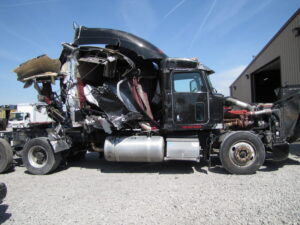
As complex pieces of equipment, commercial trucks are subject to significant regulation by the state of Missouri and the federal government. Laws specific to large trucks ensure that these vehicles are safely operated on Missouri’s roads and highways. When truck drivers and trucking companies fail to comply with these laws and regulations, other motorists are put at risk of catastrophic accidents and severe injuries.
If you have been injured in a crash that wasn’t your fault, the experienced Missouri truck accident lawyers of Sumner Law Group, LLC, can help. We will use our extensive knowledge of Missouri’s trucking laws to evaluate the facts and circumstances of your case. Our experienced lawyers can determine whether violations of trucking laws and regulations played a role in your crash.
Call us or contact us online today for a free case review with a trucking accident attorney.
Vehicle Safety Requirements
To lawfully operate on the roads and highways in Missouri, commercial trucks are required to meet these state trucking regulations:
- Trucks are limited to a maximum height (including load) of 14 feet on interstates and designated highways and 13.5 feet on all other highways, except that vehicles may reach a maximum height of 15 feet in the five commercial zones of Columbia, Kansas City, Springfield, St. Joseph, and St. Louis.
- Trucks are limited to a maximum width (including load) of 102 inches.
- On interstate and designated highways, tractor-trailers have no maximum length, except that the length of the semi-trailers can be no longer than 53 feet. On all other highways, tractor-trailers are limited to a combined vehicle length of 65 feet. Other commercial trucks are limited to a maximum length of 65 feet on interstates and designated highways, and 55 feet on all other highways.
- Trucks may have no more than 20,000 pounds per axle on the interstate or 22,000 pounds on all other highways, or 34,000 pounds on a tandem axle on the interstate, and 36,000 pounds on all other highways.
- The total gross vehicle weight depends on the number of axles on the vehicle and the distance between the middle of the frontmost and rearmost axle. The most weight permitted is 80,000 pounds, with heavier vehicles required to obtain an oversize weight permit from the Missouri Department of Transportation.
- All commercial vehicles operated in interstate commerce must be marked on the side of the vehicle with the motor carrier’s legal name and US DOT identification number and the operator’s legal name (if different from the motor carrier).
- Commercial vehicles that operate in intrastate commerce (not leaving the state of Missouri) must be marked on the side of the vehicle with the motor carrier’s US DOT number followed by the marking “MO,” except that limousines or vans with 13 or fewer seats may place the marking anywhere on the rear of the vehicle. Vehicles must also be marked on one side with the name and address of the vehicle’s owner.
Commercial Truck Inspection Requirements
Commercial truck owners and operators are required to regularly inspect, maintain, and repair all trucks under their control. Motor carriers are required to keep records of trucks that have been in their control for 30 days or more, with the following information:
- The company number, vehicle make, serial number, year, and tire size
- A schedule of inspections, including type and due date
- All inspection, maintenance, and repair records
Carriers are also required to have truck drivers prepare a written post-trip inspection report at the end of each driving day where the driver discovers or is informed about a vehicle defect (such as during a traffic stop or roadside inspection). The report must cover:
- Brakes, including trailer brake connections
- Parking (hand) brake
- Coupling devices
- Wheels and rims
- Tires
- Steering
- Lighting devices and reflectors
- Horn
- Rearview mirror
- Windshield wipers
- Emergency equipment
- Any condition that would affect the safety of the vehicle in operation or cause a breakdown
Before the truck can be driven again, the carrier must certify that any defect or deficiency noted in a driver’s post-trip inspection report was either corrected or that the condition does not require immediate correction. Drivers must also determine that the truck can be safely operated.
Carriers may have trucks periodically inspected either by a third-party inspector or by a qualified individual employed by the carrier. Qualified inspectors must:
- Understand the inspection standards set forth in federal regulations
- Know how to identify defective parts
- Have gained experience in inspection either by completing a training program or obtaining a state or Canadian province certificate in commercial motor vehicle safety inspection ─ or have at least one year of practical training or experience
Carriers must keep documents that show an inspector’s qualifications for at least one year following the last inspection.
Truck Driver Safety Requirements
Truck drivers must hold a Missouri commercial driver’s license to operate a commercial truck. Drivers must meet other requirements, including:
- Being at least 18 years old to drive in intrastate commerce, or at least 21 years old to operate in interstate commerce or to transport hazardous materials intrastate or interstate
- Speaking and reading English well enough to communicate with others, respond to official questions, read road signs, and complete reports and records
- Having the physical capability to safely operate the vehicle
- Knowing how to safely load, block, brace, and secure cargo
Carriers that employ drivers are required to keep the following documents as part of the driver’s employment record:
- The driver’s employment application
- The carrier’s inquiries to previous employers over the past three years
- The carrier’s inquiries to state agencies over the past three years
- Annual review of the driver’s driving record
- The driver’s annual certification of violations
- The driver’s road test certificate (or an equivalent document)
- The driver’s medical examination record and, if applicable, Skills Performance Evaluation Waiver
- The training certificate for an entry-level driver
Truck drivers must follow certain hours-of-service (HOS) limitations:
- Drivers are limited to 14 hours on duty and 11 hours driving before being required to take a 10-hour resting period prior to the next duty shift.
- Drivers are limited to no more than 60 hours on duty in any seven-consecutive-day period, or 70 hours on duty in any eight-consecutive-day period. A driver can restart these periods by taking at least 34 consecutive hours off duty.
- Drivers may not drive longer than eight hours since their last off-duty or sleeper-berth rest period of at least 30 minutes.
Drivers are required to keep a log of their on-duty and driving time, unless they operate within a 100-mile air radius of their work-reporting location and return to that location at the end of their shift.
Truck drivers are considered driving under the influence (DUI) of alcohol if they have a BAC of 0.04 percent or greater. Drivers also may not keep open containers of alcohol in their cab.
 Talk to a Knowledgeable Truck Accident Lawyer Now
Talk to a Knowledgeable Truck Accident Lawyer Now
If you have been the victim of a truck accident, you deserve financial recovery for your injuries and losses. Contact us today for a free consultation with a Missouri truck accident lawyer from Sumner Law Group, LLC.

















